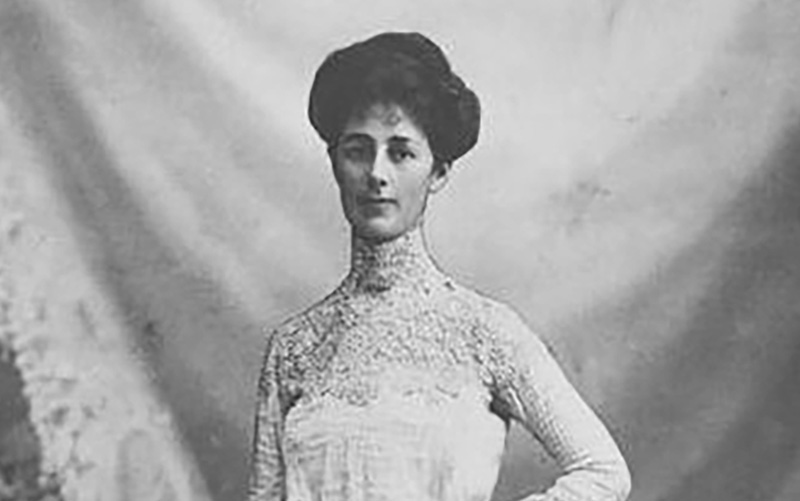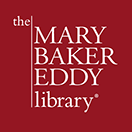Women of History: Vida Goldstein

Portrait of Vida Goldstein, circa 1900–1909, National Library of Australia, nla. obj-136682563.
Vida Jane Goldstein (1869–1949) was a leading Australian suffragist and peace activist. She was also a Christian Scientist. In 1906 the press reported that she was “probably the most famous woman in the Commonwealth” and “earned this distinction by her championship of women’s rights throughout Australia.1
For Goldstein, religion and social reform were not mutually exclusive. She became a student of Christian Science in her twenties, while a rising star in Australian women’s suffrage. Even after she exchanged public life for the public practice of Christian Science healing in the 1920s, she remained committed to social issues and emphasized the importance of improving women’s lives.
Goldstein was born in Portland, Victoria, on April 13, 1869, the oldest of five children. In her 1993 biography That Dangerous and Persuasive Woman, author Janette Bomford points out that Goldstein’s parents, Jacob and Isabella Goldstein, prioritized religion as well as social justice:
Both parents were devout Christians and the importance of a spiritual life was deeply instilled in Vida. Isabella was a Presbyterian and Jacob a Unitarian…. While helping the less fortunate is part of a Christian’s duty, and many middle-class people made a hobby of it, Isabella and Jacob were genuinely compassionate and motivated by a fundamental sense of justice and equality…. From an early age Vida was made aware of the plight of the poor.2
A talented student, Goldstein received glowing progress reports throughout her youth, first from governesses and then as a pupil at the Presbyterian Ladies College. Andrew Harper, the school’s principal, remarked that she was one of the college’s most grounded pupils.3 Historian Clare Wright notes the excellent education that Goldstein received; in her 2018 book You Daughters of Freedom: The Australians Who Won the Vote and Inspired the World, she explains that the College “…had built a reputation for educating the daughters of the colonial elite to the same standards as their sons.”4
At college Goldstein first “led the light-hearted social life of the debutante, attending balls and parties.”5 However her own intellectual curiosity, combined with an awareness of prevailing social inequities, brought her to a different path. By her early twenties she was already a committed suffragist. Her adult life began at a time of immense social change, which profoundly influenced the choices she made:
When Vida turned twenty-one in 1890, Australia was entering an economic depression. Victoria was the State most severely affected as financial institutions went bust and unemployment burgeoned. The Depression had two direct effects on Vida: it forced her to earn her own living, and the suffering which she saw at this time culminated in her decision to dedicate her life to alleviating such distress.6
The 1890s were also years of religious ferment, and Christian Science was slowly gaining adherents in Australia, having been founded a couple of decades earlier in America by Mary Baker Eddy. William W. Virtue published the first testimony of healing from Australia in an 1899 issue of the Christian Science Sentinel.7 While there are no clear indications of when Goldstein first heard of the religion, it may have been around 1885, when she was attending the Australian Church in Melbourne with her mother and sisters. The minister, Reverend Charles Strong, “formed the Religious Science Club to examine religious questions, including world religions and comparative religions, in a scientific manner.”8 Christian Science may have been one of the faiths examined.
Melbourne was one of Australia’s first cities where Christian Science gained a foothold. According to a history of First Church of Christ, Scientist, Melbourne, Eddy’s book Science and Health with Key to the Scriptures was presented to its public library around 1893, by “a visitor from America or England.” Goldstein joined The Mother Church in 1902; her mother and sister Aileen joined the following year. (Christian Scientists often hold membership both in The Mother Church in Boston and in a local branch church.) By the time of Eddy’s death in 1910, there were four branch churches in Australia and at least 1,000 adherents there.9
As Goldstein was developing her faith, she was also paying attention to social and political issues. Her first role within the suffrage movement involved door-to-door canvassing for signatures.10 Throughout the 1890s she became increasingly prominent. Wright observes:
Vida made her first public speech at a woman suffrage meeting at the Prahran Town Hall in July 1899. A month later she addressed a packed audience at the Melbourne Town Hall, where she shared the stage with Alfred Deakin, Reverend Strong, and the Mayor of Melbourne. She spoke in what would become her characteristic style; calm, rational, measured; able to reach every corner of the hall….11
In addition to these considerable skills, she deployed her quick wit in the work, and collaborated with other suffrage leaders across the country.
In September 1900 Goldstein founded a monthly journal, The Women’s Sphere, which contained reporting on the Australia and worldwide suffrage movement.12 She attended a 1902 international women’s suffrage conference in Washington, D.C., where her address was well received—attendees called her “Little Australia.”13 She also met President Theodore Roosevelt.14 This was the first of many international trips Goldstein would embark on in support of suffrage.
The following year she became one of the first women in the British Empire to run for a parliamentary seat. While never winning an election, she ran five more times as an independent, emphasizing “the necessity of women putting women into Parliament to secure the reforms they required.”15
Throughout these years white women were gaining the right to vote—first in South Australia, where aboriginal women were also enfranchised (1895), and in Western Australia (1899). The Commonwealth Franchise Act of 1902 included white women’s access to the ballot in national elections, and the right to stand for and hold elected office. By 1911 all Australian states had passed women’s suffrage legislation. Aboriginal Australians and other non-white women and men only gradually gained voting rights at the state and national levels over the next half-century. In the United States, the women’s suffrage movement was active in the same era; women were given the vote through the Nineteenth Amendment to the Constitution, ratified in 1920 (see a previously published Women of History blog on Susan B. Anthony).
World War I strengthened Goldstein’s pacifist views. Along with her work in the suffrage movement and Australian politics, she helped found the Women’s Peace Army, which according to Bomford was devoted “solely to peace propaganda.”16 The Great War touched Goldstein personally as well; her brother Selwyn was killed on the front lines in Europe.17
But after the War, Goldstein began to shift her priorities. She gradually scaled back her political involvement until, by the mid-1920s, she had put public appearances and campaigning aside, in order to practice Christian Science healing full time. While she wrote less about this commitment to a spiritual cause (she does not appear to have published anything in the Christian Science magazines), records show that she was first listed as a Christian Science practitioner in December 1928 and maintained a healing practice until her death in December 1949. Her sister Aileen was also a practitioner, and the two shared an office for a number of years in central Melbourne.18
She remained interested in social causes at home and abroad. Bomford gives some clues as to how Goldstein’s practice of Christian Science motivated her during World War II:
Vida responded to the war by campaigning for peace through prayer and exhorting the nation’s leaders to return society to godliness as the only sure way of winning victory…. Vida and her sisters also provided practical aid by sending food parcels overseas every month…. They sent the parcels to friends in England, as well as to poor districts which had been bombed and to old-age pensioners.19
In later years Goldstein maintained connections with friends from the suffrage movement. This included Helen Archdale, a fellow Christian Scientist from England who visited her in Australia. On at least one occasion, several veteran suffragists joined them for tea.20
According to Clare Wright, “Vida Goldstein was one woman who was utterly alive to the great challenge of the time.”21 That challenge lay in convincing the world to take the rights of women seriously. Goldstein not only rose to the task but lent her understanding of God to its achievement. This helped her make a lasting impact on people and communities in need.
Listen to "Women of History from the Mary Baker Eddy Library Archives," a Seekers and Scholars podcast episode featuring Library staffers Steve Graham and Dorothy Rivera.
- “Miss Vida Goldstein,” The Daily News (Perth), 26 February 1906, 4, https://trove.nla.gov.au/newspaper/article/82681203.
- Janette M. Bomford, That Dangerous and Persuasive Woman, (Melbourne, Australia: Melbourne University Press, 1993), 2.
- Bomford, That Dangerous and Persuasive Woman, 5–7.
- Clare Wright, You Daughters of Freedom: The Australians Who Won the Vote and Inspired the World, (Melbourne, Australia: Text Publishing, 2018), 39.
- Bomford, That Dangerous and Persuasive Woman, 10.
- Bomford, That Dangerous and Persuasive Woman, 12.
- “From Australia,” Christian Science Sentinel, 29 June 1899.
- Bomford, That Dangerous and Persuasive Woman, 10.
- Jill Roe, “Testimonies from the Field,” Journal of Religious History, October 1998, 318.
- Bomford, That Dangerous and Persuasive Woman, 17.
- Wright, You Daughters of Freedom: The Australians Who Won the Vote and Inspired the World, 44.
- Wright, You Daughters of Freedom: The Australians Who Won the Vote and Inspired the World, 44.
- Bomford, That Dangerous and Persuasive Woman, 39.
- Wright, You Daughters of Freedom: The Australians Who Won the Vote and Inspired the World, 105.
- “Miss Goldstein at Brunswick,” The Argus (Melbourne, Victoria), 17 March 1910, 4. http://nla.gov.au/nla.news-article10842447.
- Bomford, That Dangerous and Persuasive Woman, 147.
- Bomford, That Dangerous and Persuasive Woman, 183.
- Bomford, That Dangerous and Persuasive Woman, 204.
- Bomford, That Dangerous and Persuasive Woman, 210–211.
- Bomford, That Dangerous and Persuasive Woman, 216.
- Wright, You Daughters of Freedom: The Australians Who Won the Vote and Inspired the World, 39.

